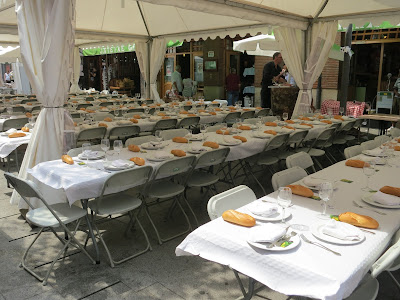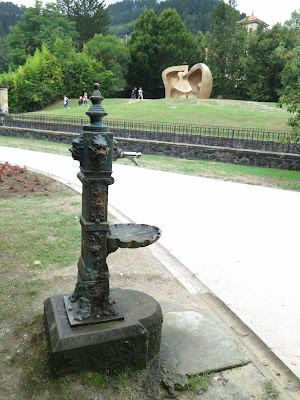Our first
stop in the Basque Country was Guernica. It was quite a strange experience as
obviously there was a fiesta going on. There was a huge fair at the end of the
town and most of the people were wearing a blue and white scarf around their
necks. When I asked about it in the tourist office I was told that it’s the
fiesta of San Roke.
We saw that
they were making food in huge pots on the main square and wherever you went
there were big tables set up for the people of Guernica.
While the
cooking was going on nothing much happened so we decided to look around. Away
from the city centre the town was all quiet.
The town’s
name is connected forever with the bombing that occurred here in 1937 during
the Spanish Civil War. The place was not directly involved in the war however
it did house some of the republican troops and was a retreat post for them to
Bilbao. It was famously a playground for Hitler’s Luftwaffe who wanted to test
the air force before the main event, World War II. They destroyed one third of
the town’s buildings and many civilians although the number is disputable.
Franco did
everything to keep it a secret from the world but Picasso’s famous painting
that bears the same name as the town, made sure it didn’t happen. At first the
painter was accused of using his talent as propaganda but later Guernica was
declared a masterpiece. Although the original Picasso painting is in Madrid in
the Sofia Reina Museum there is a life-size copy of it made of ceramics on one
of the city’s wall. I have to admit I wasn’t able to look at it for long.
Maybe you
remember that just like Catalonia, the Basque Country wants independence from
Spain as well, but unlike Catalonia, they were asking for this with violence.
Nowadays the violence has disappeared but the desire to be separated from the
main country is still alive.
The town is
also famous for an oak tree, the Tree of Guernica. During the middle ages, the
local representatives would assemble under big trees. Later this role was taken
over by the Tree of Guernica and from about 1512 it gave place to the General
Assembly of Bizkaia. The original tree was planted in the 14th century and
lived for 450 years. The tree´s trunk that can be seen today is the third
generation of the original and miraculously was not damaged by the heavy bombing
of the town. It later died of fungus but the government kept a few spare trees
from it just in case. It can be visited in front of the Casa de Juntas (Meeting
House).
I was
desperate to go inside the Casa de Juntas as I wanted to know more about the
history and there’s a beautiful ceiling painting that I really wanted to see
but that day it was not open, probably because of the fiesta.
We also
visited the Park of the European Nations. It’s a lovely green space just above
the city that offers four different routes you can try around the city, you
just have to follow the signs. We were conscious of the time so couldn’t try
any of them but did have a little stroll around the park. Amongst other things
we discovered a statue by Henry Moore, the ‘Large Figure in a shelter’.
A few more
photos of the city.
Later when
all the food was eaten there was music and dancing on the main streets of the
town.
In many places there were small stages or spontaneous orchestras set up. We found this
one man band (the guy wearing a green top) who managed to make a huge crowd
dance.
At 6pm my
favourite part of the Spanish fiestas happened: they brought out the giants!
The giants themselves weren’t that interesting however there were some guys
running around in front of them wearing only a giant’s head.
They had a
soft ball in their hands that was hanging off what looked like long socks.
Suddenly all the children from the surrounding squares gathered around them. I
knew something was about to happen, something more than a procession. Well,
those guys wearing the giant’s heads used the soft balls to chase the children
and whack them on their behinds! It was hilarious to see how the children crept
closer and closer to the guys from every direction until suddenly one giant
head turned around and started chasing them and all the children ran off into one
of the side streets. Here’s a little video about it.
When they
stopped to have a little rest I sneaked a quick look inside the giant lady.
I also
spotted a little orchestra playing music. As this was the first Basque music I
heard I was eager to listen in.
Everybody in
the town was there. They were dancing or sitting at the tables after the food
was all cleared away. The whole place had a happy, content atmosphere where all
was about the fiesta, the music and the community.
With this
our time in Guernica came to end. Yes, bombing did happen here and changed the
course of history forever but it’s in the past and now Guernica is town like
any other having their saint’s feast day. For many people Guernica is a place
where the bombing happened. For us it’s the first place we experienced a real
Basque fiesta and this is the memory I choose to keep about it. We said good
bye with a smile.










































Regards from Basque Country
ReplyDeleteEl primen contacto de un matrimonio húngaro con Euskadi: Gernika
http://bit.ly/18iuqxR